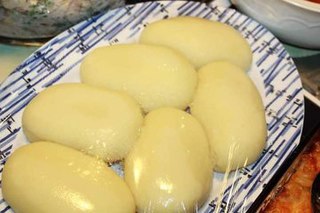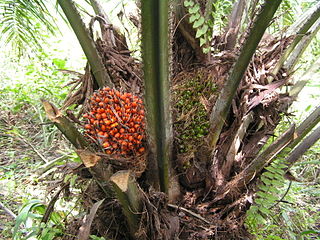
Fufu is a pounded meal found in West African cuisine. It is a Twi word that originates from the Akans in Ghana. The word has been expanded to include several variations of the pounded meal found in other African countries including Sierra Leone, Guinea, Liberia, Cote D'Ivoire, Burkina Faso, Benin, Togo, Nigeria, Cameroon, the Democratic Republic of Congo, the Central African Republic, the Republic of Congo, Angola and Gabon. It also includes variations in the Greater Antilles and Central America, where African culinary influence is high.

Palm butter or palm cream, frequently known as moambe, mwambe or nyembwe, is an ingredient made from the pericarp of palm nuts, the fruit of the African oil palm tree. It forms an important ingredient in stews and sauces in African cuisine.

Ugali, also known as posho, nsima, papa, pap, sadza, isitshwala, akume, amawe, ewokple, akple, and other names, is a type of corn meal made from maize or corn flour in several African countries: Kenya, Uganda, Tanzania, Zimbabwe, Zambia, Lesotho, Eswatini, Angola, Mozambique, Namibia, Democratic Republic of the Congo, Malawi, Botswana and South Africa, and in West Africa by the Ewes of Togo, Ghana, Benin, Nigeria and Cote D'Ivoire. It is cooked in boiling water or milk until it reaches a stiff or firm dough-like consistency. In 2017, the dish was added to the UNESCO Representative List of the Intangible Cultural Heritage of Humanity, one of a few foods in the list.

The culture of the Democratic Republic of the Congo is extremely varied, reflecting the great diversity and different customs which exist in the country. Congolese culture combines the influence of tradition to the region, but also combines influences from abroad which arrived during the era of colonization and continue to have a strong influence, without destroying the individuality of many tribal customs.

Ugandan cuisine consists of traditional and modern cooking styles, practices, foods and dishes in Uganda, with English, Arab, and Asian influences.

The cuisine of the Democratic Republic of the Congo and the Republic of the Congo varies widely, representing the food of indigenous people. Cassava, fufu, rice, plantain and potatoes are generally the staple foods eaten with other side dishes.

Ghanaian cuisine refers to the meals of the Ghanaian people. The main dishes of Ghana are centered around starchy staple foods, accompanied by either a sauce or soup as well as a source of protein. The primary ingredients for the vast majority of soups and stews are tomatoes, hot peppers, and onions. As a result of these main ingredients, most Ghanaian jollof rice, soups, and stews appear red or orange.

Thaumatococcus daniellii, also known as miracle fruit or miracle berry, is a plant species from tropical Africa of the Marantaceae family. It is a large, rhizomatous, flowering herb native to the rainforests of western Africa in Sierra Leone, southeast to Gabon and the Democratic Republic of the Congo. It is also an introduced species in Australia and Singapore.

Ndolé is a Cameroonian dish consisting of stewed nuts, ndoleh, and fish or beef.

Miang kham is a traditional Southeast Asian snack from Thailand and Laos. It was introduced to the Siamese court of King Rama V by Princess Dara Rasmi. In Laos, most people call it miang. The name miang kham translates to 'one bite wrap', from miang and kham.

A great variety of cassava-based dishes are consumed in the regions where cassava is cultivated. Manihot esculenta is a woody shrub of the spurge family, Euphorbiaceae, native to South America, from Brazil, Paraguay and parts of the Andes.

Pepes is an Indonesian cooking method using banana leaves as food wrappings. The banana-leaf package containing food is secured with lidi seumat and then steamed or grilled on charcoal. This cooking technique allows the rich spice mixture to be compressed against the main ingredients inside the individual banana-leaf package while being cooked and also adds a distinct aroma of cooked or burned banana leaves. Although being cooked simultaneously with food, the banana leaf is a non-edible material and is discarded after consuming the food.

The cuisine of Rwanda is based on local staple foods produced by the traditional subsistence-level agriculture and has historically varied across different areas.

Angolan cuisine has many dishes popular among nationals and foreigners, including funge, mufete, calulu, moamba de galinha, moamba de ginguba, kissaca, and mukua sorbet.

Moambe chicken is a savory chicken dish popular in Central Africa and considered the national dish of Angola, the Republic of the Congo, and the Democratic Republic of the Congo. The dish itself is made by combining chicken, spices and palm butter to create a stew-like consistency. A number of local or regional variations exist across the Congo and Central Africa; the dish is also known outside the continent.
Pará cuisine refers to the traditional cuisine native to Pará, Brazil. Foods from this region primarily draw influence from Indian, African, and Portuguese cultures. The core ingredients are sourced from the Amazon jungle, and may include meats such as shrimp, crab, seafood, fish, poultry, bush meat, and duck; these are all cooked with leaves, peppers, and herbs. Dishes are cooked in clay pots or barbecued in moquéns and soaked in tucupi, a yellow sauce extracted from wild manioc root native to the Amazon. Dishes may be served in bowls, in containers of clay, wrapped in cocoons of banana leaves, or in urupemas.

Cassava production is important to the economy of the Republic of the Congo as it is its prime crop. The importance of cassava consumption is reflected in the country's popular song, "The Congolese Love Cassava". It is consumed in several forms, and marketed as paste, cossettes, foufou (flour), and chikwangue. As a staple food crop, cassava is grown in most parts of the country, except the southern region where the crops grown are banana and plantains. Cassava and yams are the primary subsistence crops grown in the country's valleys, with farmers producing five harvests per year. The Republic of the Congo, as of 1996, was the world's second largest consumer of cassava after Zaire, now known as the Democratic Republic of the Congo.

Megaphrynium macrostachyum is a species of large plant in the Marantaceae family native to tropical Africa. It grows in moist places and regenerates rapidly after ground disturbance or fire. The long stems have various uses in making cord, baskets and mats, and the large leaves are used for wrapping food, for making utensils and containers, and in herbal medicine.

Nasi tutug oncom or sometimes simply called tutug oncom, is an Indonesian style rice dish, made of rice mixed with oncom fermented beans, originally from Tasikmalaya, West Java. It is usually wrapped in banana leaves and served with various side dishes.

















